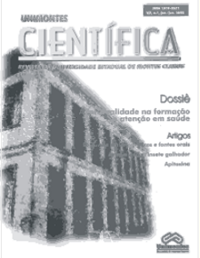Ataque de um inseto galhador (Diptera: Cecidomyiidae) em Astronium fraxinifolium (Anacardiaceae) em uma floresta estacional
Keywords:
Hipótese do Vigor, Hipótese da Arquitetura, resistência da planta, galhasAbstract
Muitas hipóteses têm sido propostas para explicar a variação na riqueza e abundância de insetos herbívoros em
hospedeiros coespecíficos. Este estudo descreve o padrão de ataque de um inseto galhador (Diptera: Cecidomyiidae) em
Astronium fraxinifolium, testando as Hipóteses do Vigor e da Arquitetura da Planta Hospedeira. Para testar estas hipóteses,
a preferência para oviposição da fêmea do galhador foi avaliada contando-se o números de ataques do galhador em dez
ramos de dez árvores adultas, localizadas na reserva da COPASA, em Juramento (MG). Os resultados do estudo indicam
que a resistência da planta hospedeira constitui o principal fator de mortalidade do galhador. Além disto, as fêmeas do
inseto galhador atacam preferencialmente ramos mais vigorosos e plantas estruturalmente mais complexas, corroborando as Hipóteses do Vigor e da Arquitetura da planta. Entretanto, quando se analisa apenas o número de galhas que
sobrevivem, escapando das defesas da planta, este padrão de ataque se torna pouco conspícuo. Assim, estes fatores de
mortalidade devem ser considerados com mais atenção em outros estudos que envolvem interações entre herbívoros e
suas plantas hospedeiras.
Downloads
References
Psyllidae), galhador da folha do araçazeiro (Psidium
cattleianum). Revista Brasileira de Entomologia, 47 (1):
1-7, 2003.
CORNELISSEN, T. G. & FERNANDES, G. W. Patterns
of attack by herbivores on tropical shrub Bauhinia
brevipes (Leguminosae): Vigour or chance? European
Journal of Entomology, 98 (1): 37-40. 2001.
ENGLISH-LOEB, G., STOUT, M. J. & DUFFEY, S. S.
Drought stress in tomatoes: Changes in plant
chemistry and potential nonlinear consequences for
insect herbivores. Oikos, 79 (4): 456-468, 2002.
ESPÍRITO-SANTO, M. & FERNANDES, G. W. Host plant
effects on the development and survivorship of the
galling insect Neopelma baccharidis (Homoptera:
Psillidae). Austral Ecology. 27 (3): 249-257, 2002.
ESPÍRITO-SANTO, M., MADEIRA, B. G., NEVES, F. S.,
FARIA, M. L., FAGUNDES, M. & FERNANDES, G. W.
Sexual differences in reproductive phenology and their
consequences to the demography of Baccharis
dracunculifolia (Asteraceae), a dioecious tropical
shrub. Annals of Botany, 91 (1): 13-19. 2003.
FARIA, M. L. & FERNANDES, G. W. Vigour of a
dioecious shrub and attack by a galling herbivore.
Ecological Entomology, 26 (1): 37-45. 2001.
FAY, P. A., HARTNETT, D. C. & KNAPP, A. K. Plant
tolerance of gall-insect attack and gall-insect
performance. Ecology, 77 (4): 521-534, 1996.
FEENY, P. Plant appearance and the diversity of
phytophagous insects. Recent Advances in
Phitochemistry, 10 (1): 1-22, 1976.
FERNANDES, G. W. Hypersensitivity as a phenotypic
basis of plant induced resistance against a galling
insect (Diptera: Cecidomyiidae). Environmental
Entomology, 27 (3): 260-267. 1998.
FERRAZ, F. F. F. & MONTEIRO, R. F. Complex
interaction envolving a gall midge Myrciamia
maricaensis Maia (Diptera, Cecidomyiidae),
phytophagous modifiers and parasitoids. Revista Brasileira de Zoologia, 20 (3): 433-437, 2003.
HAWKINS, B. A. Do galls protect endophytic
herbivores from parasitoids? A comparison of galling
and non-galling Diptera. Ecological Entomology, 13 (3):
473-477, 1988.
HERMS, D. A. &, MATTSON, W. J. The dilemma of
plants: to grow or defend. The Quarterly Review of
Biology, 67 (1): 283-335, 1992.
HUNTER, M. D., OHGUSHI, T. & PRICE, P. W. Effects
of resource distribution on animal-plant interactions.
San Diego, California: Academic Press, 1992. 505p.
LAWTON, J. H. Plant architecture and the diversity
of phitophagous insects. Annual Review of Entomology,
28 (1): 23-39, 1983.
LUTTGE, U. Physiological ecology of tropical plants.
Springer-Verlag, Berlin. 1997. 384p.
MENDONÇA, R. L. Fenologia, germinação e viabilidade de sementes de Astronium fraxinifolium Schott
(Gonçalo-alves). Montes Claros: UNIMONTES, 2002.
56p. (Monografia de Graduação).
MOON, D. C., ROSSI, A. M. & STILING, P. The effects
of abiotically induced changes in host plant quality
(and morphology) on salt marsh plant hopper and its
parasitoids. Ecological Entomology, 25 (3): 325-331,
2000.
NUNES, Y. R. F., FAGUNDES, M., SANTOS, R. M.,
DOMINGUES, E. B. S., MENDONÇA, R. L. & CASTRO,
G. C. 2003. Fenologia comparativa de duas espécies
de Anacardiaceae: Myracrodruon urundeuva (aroeira)
e Astroniun fraxinifolium (gonçalo-alves). CONGRESSO DE ECOLOGIA DO BRASIL, 6. 2003. Fortaleza. Anais
de trabalhos completos. Universidade Federal do
Ceará., 2003. p. 487-488.
PRICE, P. W. The plant vigor hypothesis and herbivore
attack.. Oikos, 62 (2): 244-251, 1991.
RIZZINI, C. T. Tratado de fitogeografia do Brasil: aspectos ecológicos, sociológicos e florísticos. Rio
de Janeiro: Âmbito Cultural, 1997. 747p.
TRUMBULE, R. B. & DENNO, R. F. Light intensity,
host-plant irrigation, and habitat-related mortality as
determinants of the abundance of azalea lace bug
(Heteroptera: Tingidae). Environmental Entomology, 24
(6): 898-908, 1995.
WASHBURN, J. O., GRACE, J. K. & FRANKIE, G. W.
Population response of Pulvinariella mesembryanthemi
and Pulvinaria delottoi (Homoptera: Coccidae) to
nitrogen and water conditions of their host plant.
Environmental Entomology, 16 (3): 286-295, 1987.
WOODS, J. O., CARR, P. W., PRICE, P. W., ESTEVENS,
L. E. & COBB, N.S. Growth of Coyote Willow and the
attack and survival of a mid-rib galling sawfly, Euura
sp. Oecologia, 108 (6): 714-722, 1996.
YUKAWA, J. Syncronization of gallers with host plant
phenology. Population Ecology, 42 (2): 105-113, 2000.
ZAR, J. H. Biostatistical Analysis. Prentice Hall,
Englewood Cliffs, New Jersey. 1996. 689p.












